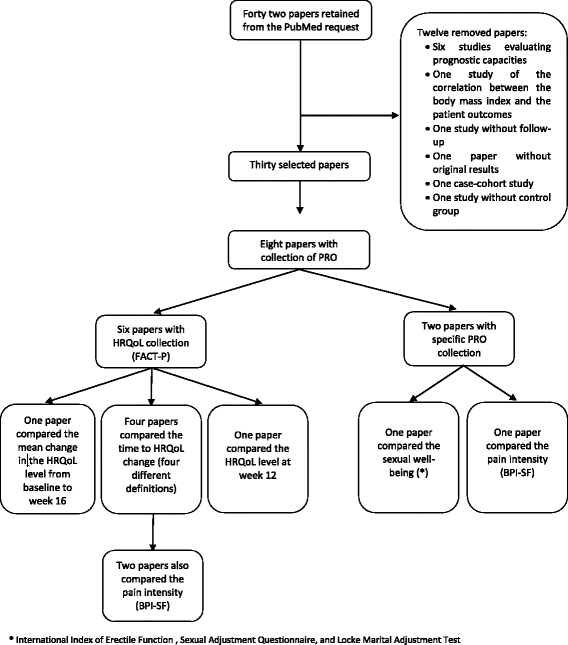A mini-review of quality of life as an outcome in prostate cancer trials: patient-centered approaches are needed to propose appropriate treatments on behalf of patients
- PMID: 29506537
- PMCID: PMC5836440
- DOI: 10.1186/s12955-018-0870-6
A mini-review of quality of life as an outcome in prostate cancer trials: patient-centered approaches are needed to propose appropriate treatments on behalf of patients
Abstract
Background: Patients with prostate cancer (PC) may be ready to make trade-offs between their quantity and their quality of life. For instance, elderly patients may prefer the absence of treatment if it is associated with a low-risk of disease progression, compared to treatments aiming at preventing disease progression but with a substantial deterioration of their Health-Related Quality of Life (HRQoL). Therefore, it seems relevant to compare the treatments by considering both survival and HRQoL. In this mini-review, the aim was to question whether the potential trade-offs between survival and HRQoL are considered in high impact factor journals.
Methods: The study was conducted from the PubMed database for recent papers published between May 01, 2013, and May 01, 2015. We also restricted our search to nine medical journals with 2013 impact factor > 15.
Results: Among the 30 selected studies, only six collected individual HRQoL as a secondary endpoint by using the Functional Assessment of Cancer Therapy-Prostate (FACT-P) questionnaire. In four studies, the time to HRQoL change was analyzed, but its definitions varied. In two studies, the mean changes in HRQoL between the baseline and the 12- or 16-week follow-up were analyzed. None of the six studies reported in a single endpoint both the quantity and the quality of life.
Conclusions: Our mini-review, which only focused on recent publications in journals with high-impact, suggests moving PC clinical research towards patient-centered outcomes-based studies. This may help physicians to propose the most appropriate treatment on behalf of patients. We recommend the use of indicators such as Quality-Adjusted Life-Years (QALYs) as principal endpoint in future clinical trials.
Keywords: Patient-centered outcomes; Prostate cancer; Quality of life; Review of clinical trials.
Conflict of interest statement
Ethics approval and consent to participate
Not applicable.
Consent for publication
Not applicable.
Competing interests
The authors declare that they have no competing interests.
Publisher’s Note
Springer Nature remains neutral with regard to jurisdictional claims in published maps and institutional affiliations.
Figures
Similar articles
-
Assessment of quality of life in advanced, metastatic prostate cancer: an overview of randomized phase III trials.Qual Life Res. 2017 Apr;26(4):813-822. doi: 10.1007/s11136-016-1429-9. Epub 2016 Oct 13. Qual Life Res. 2017. PMID: 27738867 Review.
-
From QOL to QALYs: Comparing nononcologic outcomes in prostate cancer survivors across treatments.Urol Oncol. 2017 Feb;35(2):69-75. doi: 10.1016/j.urolonc.2016.07.019. Epub 2016 Aug 26. Urol Oncol. 2017. PMID: 27575917 Review.
-
Health-related quality of life, satisfaction, and economic outcome measures in studies of prostate cancer screening and treatment, 1990-2000.J Natl Cancer Inst Monogr. 2004;(33):78-101. doi: 10.1093/jncimonographs/lgh016. J Natl Cancer Inst Monogr. 2004. PMID: 15504921 Review.
-
A prospective study of health-related quality-of-life outcomes for patients with low-risk prostate cancer managed by active surveillance or radiation therapy.Urol Oncol. 2017 May;35(5):234-242. doi: 10.1016/j.urolonc.2016.12.015. Epub 2017 Jan 19. Urol Oncol. 2017. PMID: 28110975
-
Setting an Agenda for Assessment of Health-related Quality of Life Among Men with Prostate Cancer on Active Surveillance: A Consensus Paper from a European School of Oncology Task Force.Eur Urol. 2017 Feb;71(2):274-280. doi: 10.1016/j.eururo.2016.09.041. Epub 2016 Oct 6. Eur Urol. 2017. PMID: 27720532
Cited by
-
Quality of life in men with metastatic prostate cancer in their final years before death - a retrospective analysis of prospective data.BMC Palliat Care. 2018 Dec 3;17(1):126. doi: 10.1186/s12904-018-0381-6. BMC Palliat Care. 2018. PMID: 30509249 Free PMC article.
-
Meta-analysis of predictive models to assess the clinical validity and utility for patient-centered medical decision making: application to the CAncer of the Prostate Risk Assessment (CAPRA).BMC Med Inform Decis Mak. 2019 Jan 7;19(1):2. doi: 10.1186/s12911-018-0727-2. BMC Med Inform Decis Mak. 2019. PMID: 30616621 Free PMC article.
References
-
- D’Amico AV, Whittington R, Malkowicz SB, Schultz D, Blank K, Broderick GA, et al. Biochemical outcome after radical prostatectomy, external beam radiation therapy, or interstitial radiation therapy for clinically localized prostate cancer. JAMA. 1998;280:969–974. doi: 10.1001/jama.280.11.969. - DOI - PubMed
-
- Cooperberg MR, Pasta DJ, Elkin EP, Litwin MS, Latini DM, Du Chane J, et al. The University of California, san Francisco cancer of the prostate risk assessment score: a straightforward and reliable preoperative predictor of disease recurrence after radical prostatectomy. J Urol. 2005;173:1938–1942. doi: 10.1097/01.ju.0000158155.33890.e7. - DOI - PMC - PubMed
Publication types
MeSH terms
Grants and funding
LinkOut - more resources
Full Text Sources
Other Literature Sources
Medical


